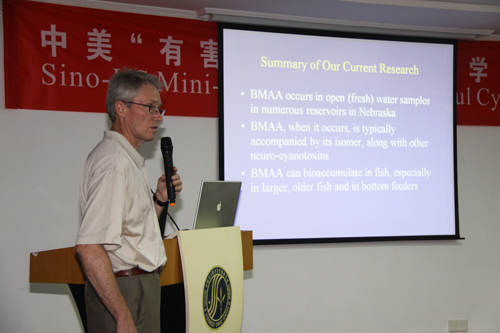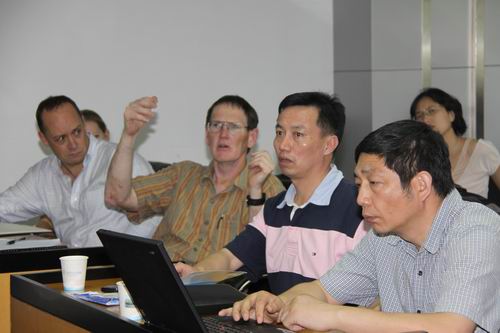
International
Sino-US Mini-symposium on “Harmful Cyanobacteria”

Professor Kyle Hoagland, from the University of Nebraska, introduced the distribution of BMAA in the waters of Nebraska and its influence on aquatic vegetation.
The Sino-US Mini-symposium on “Harmful Cyanobacteria” was held at Institute of Hydrobiology, Chinese Academy of Sciences (IHB) on June 23. The symposium was chaired by IHB Prof. Li Renhui. Three professors from the United States attended the symposium.
Professor Steven Wilhelm, from University of Tennessee, reported the recent research revealing the relationship between microbial community structure and the occurrence of cyanobacterial blooms by metagenomic and metaproteomic analyses. Professor Greg Boyer, from the State University of New York, introduced the distribution and detection of cyanotoxinsin the Great Lake regions in the United States. Professor Kyle Hoagland, from the University of Nebraska, presented their study on the distribution of BMAA in the waters of Nebraska and its influence on aquatic vegetation.
IHB Prof. Song Lirong introduced the comparative study on the dynamics of cyanobacterial blooms in large shallow lakes of China, revealing that climate and nutrition have a major role in the formation of cyanobacterial blooms. IHB Prof. Li Renhui presented the molecular characterization and monitoring of Geosmin- and MIB- associated genes in cyanobacteria and Chinese waters.

Prof. Steven Wilhelm from University of Tennessee (1st L), Prof. Greg Boyer from the State University of New York (2nd L), Prof. Li Renhui from IHB (3rd L), Prof. Song Lirong (4th L)
The symposium provided a platform for discussing on the formation and distribution of cyanobacterial blooms, on their metabolic outcomes and dynamic changes. The symposium strengthens the connection between both researchers and also promotes the academic exchanges and cooperation between institutions in China and the U.S.

A group photo of the attendees